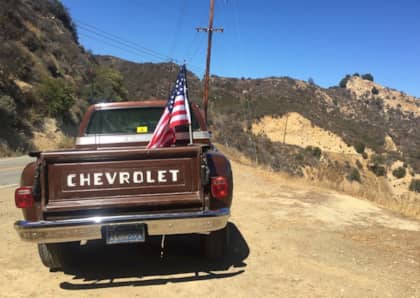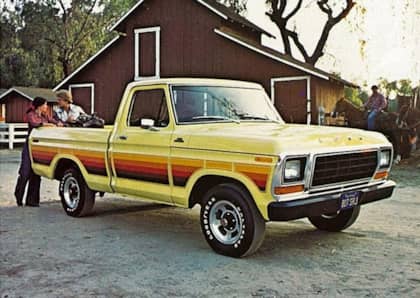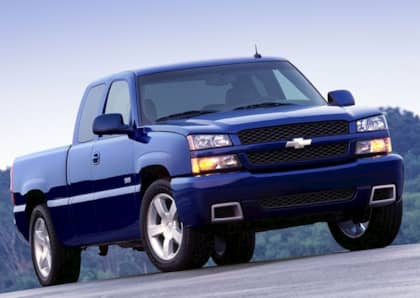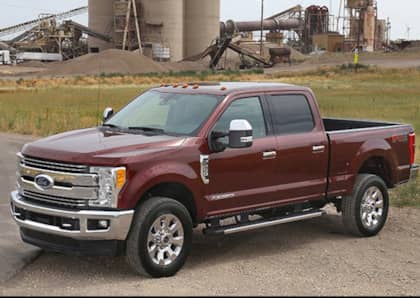Storm on the Horizon: Tracing Today's Super-SUV Origins
America loves trucks. It’s an undeniable fact, with pickups leading the sales charts for decades and “crossover” vehicles pushing the old-school station wagon and minivan completely out of the picture. Instead of utilitarian appliances for getting people and stuff from here to there, they’ve become the family car, a status symbol and most improbably, they’ve even cut into sports car territory.
The 2018 Jeep Grand Cherokee Trackhawk has a supercharged V8 engine that delivers 707hp and despite tipping the scales at 5,258 lbs, it will run 0-60 in 3.5 seconds. The Trackhawk will also lighten your wallet by a minimum of $86,995.

A rung down the ladder in raw performance and horsepower, but a big step up in prestige and price tag, you’ll find the Porsche Cayenne Turbo S. In exchange for nearly double the Trackhawk’s MSRP at $160,650, you get a twin-turbo V8 with 570hp, translating to 3.8 second 0-60 times. Handling isn’t ignored either, with the Turbo S running sub-eight-minute Nürburgring laps.

BMW also offers a similar twin turbo V8 über-SUV, the $101,695, 567hp X5 M with essentially identical performance to their long-time rival’s top “truck”. Add in Lamborghini’s recently announced Urus and Ferrari’s interest in creating their own SUV, and the “sport truck” market is far more crowded than when that name was coined more than two decades ago. Insane performance (and equally insane price tags) are the rule, but back at the dawn of the ‘90s, the idea of a powerful engine and full-time AWD stuffed into a truck or SUV chassis was merely insane.

Turbocharge All the Things!
The end of the 1980s was a golden age for crazy ideas at General Motors. Coming off the smog-choked and oil-embargoed ‘70s, GM began throwing turbochargers at their tried and true 4- and 6-cylinder engines, creating some noteworthy hits—the 3.8L V6 that powered the now-legendary turbo Buicks—and some forgettable misses—anybody recall the Pontiac Sunbird Turbo? Inevitably, General Motors’ truck-centric GMC division caught the fever as well and began plans for their own turbocharged “halo” vehicle.
Dating back to the original GTO that dropped a 325hp V8 into the (relatively) compact 1964 Pontiac Tempest, the idea of marrying a high output engine with a small chassis wasn’t a new one, but the concept of a “sport truck” wasn’t something any manufacturer had taken seriously. As the ‘80s drew to a close, the only factory trucks with performance aspirations were oddballs like Dodge’s Lil' Red Express, available for just the ‘78-’79 model years and boasting mediocre high 15-second quarter mile performance and big-rig-inspired styling.
Chevrolet took a stab at the concept in 1990 with the 454SS—a full-size pickup with a 230hp big block under the hood—but the true ancestor of every modern sport truck and SUV was still to come. The year before, the LD5 V6 had migrated from Buick’s discontinued Regal turbos to the Pontiac Trans Am 20th Anniversary production model, and at least one prototype Chevy S-10 had been constructed with a Grand National-spec engine under the hood.

While this “GN pickup” garnered interest, several things would change between concept and production; the truck would gain full time all-wheel drive, the 3.8L Buick V6 would be replaced with a turbocharged version of the 4.3L LB4 V6 already found in the S-series trucks and it would be branded as a GMC to provide market differentiation from Chevy’s 454SS.
First of a New Breed: The GMC Syclone
The result was the 1991 GMC Syclone (spelled that way to avoid legal issues with Ford, who still owned the “Cyclone” trademark). Its all-iron 4.3L V6 was basically three quarters of a small-block Chevy V8, sharing bore spacing, cylinder dimensions and certain components with its larger siblings, but unlike run of the mill 4.3L engines, it sported nodular iron main caps, special head gaskets and bespoke pistons to lower the compression ratio to 8.35:1.

Oh, and there was that turbo, too—a Mitsubishi TD06-17C regulated to 14.7 psi that fed air through a Garrett air-to-water intercooler and past a Corvette-spec throttle body. The engine was conservatively rated at 280hp at 4,400 rpm and 350 lb-ft of torque at 3,600, besting the 1991 Corvette’s 250hp naturally-aspirated L98 V8.

Backing the turbo V6 was a 700R4 four-speed overdrive automatic transmission, mated to a Borg-Warner transfer case to provide full time AWD through a viscous coupling. This dead-simple center differential normally directed the engine’s torque to the rear wheels, but if wheelspin caused a difference in speed between front and rear, the fluid in the coupling would progressively direct more torque to the front, up to a 35/65 split.

Other performance hardware included a lowered suspension, unique 16x8 “turbine” wheels shod in 245/50R16 Firestone all season performance tires and the first four-wheel anti-lock braking system installed on a production truck. According to contemporary magazine testing, the Syclone was capable of 4.6 second 0-60 times and 13.4 seconds at 98 mph in the quarter mile, putting it on par with the very quickest factory vehicles available in 1991.
Cosmetically, the Syclone took a page from the Buick GNX, available in any color you wanted as long as that color was black. Unique body cladding and badges further identified the Syclone, and occupants were enthroned in special black cloth seats with red piping and embroidered Syclone logos on the headrests. The instrument cluster with its integrated boost gauge came from the aforementioned Turbo Sunbird, while the shift knob was shared with the Corvette. Finally, a soft vinyl tonneau cover came standard to conceal any small cargo bouncing around in the bed.

Production was handled by PAS Inc. in Troy, Michigan, the same company that had previously built the Turbo Trans Am. Outsourcing specialty model assembly to PAS freed up capacity for the popular compact truck line at GM’s Shreveport Operations plant where the bare chassis were built.
With a base MSRP of $25,970 (about $47,600 in today’s dollars), the Syclone was a performance bargain compared to a base Corvette at $32,455, but was breathtakingly expensive when stacked up against the $15,445 1991 Camaro Z/28. It also suffered an identity crisis as a truck, with placards warning against carrying more than 500 pounds in the bed. Despite these factors, out of a projected run of just 3,000 units, 2,995 were actually built for the 1991 model year. While only three “pilot” 1992 Syclones were made, the experiment was successful enough to spawn the 1992 Typhoon.
More to Love: The GMC Typhoon
It wasn’t much of an engineering challenge to transfer the Syclone’s powerplant and AWD driveline to the GMC Jimmy 3-door SUV, as both shared the same body-on-frame underpinnings, but the 1992 Typhoon added more creature comforts. In addition to the ability to terrify more than one passenger at a time, Typhoon buyers also received leather seats and a self-leveling rear air suspension. While still rated at 280hp, the published figures for torque rose to 360 peak lb-ft, and Car and Driver reported that 0-60 times had risen to 5.3 seconds with the quarter mile passing in 14.1 seconds at 95 mph, thanks to the increased 3,822 pound curb weight (more than 200 pounds more than the Syclone.)

Though black on black would still be the most-produced color combination for 1992 Typhoons, buyers were offered a number of different combinations of body colors, including the quintessential ‘90s choice, bright teal over gray. All this could be yours in 1992 for the low, low price of just $29,530—or $52,745 today. A total of 2,497 were built for the 1992 model year, and 1993 brought another 2,200 built, with black on black again leading the color choices.

The end of the road came in 1993. With the changeover to the second-generation Sonoma and Blazer pending for the 1994 and 1995 model years, Typhoon production ended, and with it, GM’s experiment in true high-performance trucks and SUVs.
The Blue Oval Strikes Back: The F150 Lightning
Though GM was content to offer weak-sauce “performance” trucks in the following years, like the naturally-aspirated Chevy S-10 SS (which was mostly an appearance package combined with a 180-200hp 4.3L V6), Ford had taken notice. The 1993 SVT Lightning, originally intended as a competitor for the 454SS, took the full-size F-150 and added a 240hp 5.8L engine along with a suspension, wheel and tire package, but could only struggle to a 7.2 second 0-60 time. In its favor was the sub-$22,000 base price, and the fact that it was better suited to doing “truck things” than the Syclone, resulting in more than 12,000 being sold between 1993 and 1995, almost three times what the Syclone and Typhoon sold over their three-year run.

Ford took a second bite at the apple with a revised Lightning based on the tenth-generation F-150 in 1999. With a starting price of $29,995 ($45,032 today) and powered by a 5.4L Modular V8 topped by an Eaton supercharger pushing 8 psi that delivered 360 peak horsepower and a thumping 440 lb-ft of torque, the second-gen Lightning was finally creeping into SyTy performance territory with a 5.8 second 0-60 and a 14.3 second quarter mile. Detail changes added another 20hp and 10 lb-ft for the 2001 model year (and pushed the base price to $32,460, or $45,727 today), and times dropped to 5.2 seconds in the 0-60 sprint and 13.8 for the quarter mile.

Over the course of the 1999-2003 model years, Ford produced more than 28,000 SVT Lightnings, proving a market existed for performance trucks, but with the advent of the redesigned 11th generation F-150 for 2004, the model was dropped.
Not Quite the Same: The Chevy SSR and Dodge Ram SRT-10
While the Lightning was in its heyday, GM began development of the Chevrolet SSR (Super Sports Roadster), based on a concept unveiled at the 2000 Detroit Auto Show to rave reviews. The 2003 production SSR featured “retro” styling and a retractable hard top. Power for 2003 and 2004 models came from a 5.3L Vortec V8, rated at 300hp and 331 lb-ft, and when asked to drag around the SSR’s hefty 4,764 pound curb weight, the results were “meh” at best. Zero to sixty took seven seconds flat, and 15.4 at 89 mph in the quarter mile put the SSR’s performance on par with the Honda Accord V6.

For 2005, the SSR got LS2 power and output improved to 390hp and 405 lb-ft. Also new was an optional six-speed manual transmission. With the new engine and transmission, the SSR was now capable of a 5.5 second 0-60 time and ran the quarter in 14.1 seconds at 100 mph. Base pricing rose just shy of $1,200 from the SSR’s introduction, making it less expensive with inflation factored in, but it was still a lot of money for something that occupied the same territory in terms of performance and practicality as the Plymouth Prowler. The SSR didn’t truck well, didn’t have the performance enthusiasts hoped for and suffered from love-it-or-hate-it styling, all of which conspired to cause its cancellation after the 2006 model year with just over 24,000 units sold.

In 2004, Chrysler jumped into the game with what still stands as the high point of “sport truck” displacement with the Dodge Ram SRT-10. They got the engine part right, using the 8.3L, 500hp/525 lb-ft V10 engine from the Viper, but wrapped it in over 5,000 pounds of full-size pickup. Even so, 60 mph came in a mere 4.9 seconds and the quarter mile was dispatched in 13.6 seconds at 106 mph. Two-door pricing started at $45,850 ($61,068 today) and added another $5,000 for the quad cab version. Like the first and second gen Lightnings, the SRT-10 also did “truck things” reasonably well, but after three years and 9,527 units built, it too rode into the sunset in 2006.

The “Performance SUV” Hits Its Stride: The Grand Cherokee SRT8 and TrailBlazer SS
On the heels of the SRT-10’s demise, Chrysler followed up with the Jeep Grand Cherokee SRT8, debuting in 2006 with 420hp. Car and Driver compared it against Chevy’s 395hp 2006 TrailBlazer SS and found that the Chevy was nearly a second slower at the dragstrip, clocking a 14.1 to the Jeep’s 13.2, but still matching the straight-line performance of the original Typhoon. While the Grand Cherokee SRT8 remained in production through the generation change in 2011 (and gained more than 55hp), the SS ended its run after the 2009 model year with just over 26,000 sold in four years, or about 1.7 percent of total TrailBlazer production.

The 2011 SRT Grand Cherokee upgraded the V8 HEMI to a rated 475hp and 470 lb-ft but lost ground both in terms of performance and affordability. In a July 2012 Car and Driver comparison test against the BMW X5 M, Mercedes ML63 and Porsche Cayenne Turbo, the Jeep ranked last overall, but was praised for being the “bargain” of the group with an MSRP more than $34,000 lower than the winning BMW.

While Chrysler would be hard-pressed to match the snob appeal of BMW, Mercedes, or Porsche, they had a ready answer for power in the 707hp supercharged Hellcat HEMI and leapfrogged the competition with the Trackhawk.
Imitated but Never Duplicated
That brings us back to where we started, with today’s very fast, very heavy and very expensive “sport trucks” capable of performance that would shame anything you could buy at the dawn of the ‘90s. So why are the Syclone and Typhoon still so desirable? Maybe it has to do with defining the meaning of the sport truck and SUV segment, and the fact that everything that followed, from Lightning to Urus, owes a little bit to those folks at GM who took an insane idea and ran with it.

But maybe it’s that same magic that made the original GTO so special—maximum engine, minimum gingerbread. That’s something today’s super-SUVs haven’t captured, as their engine output and price tags have soared into the stratosphere. Give us a GMC Canyon standard-cab short bed or a body-on-frame three-door Chevy Blazer based on the same chassis with full time AWD and the 455hp LT1 V8 from the Camaro and Corvette. Price it to split the difference between the Camaro SS’s $38,000 base price and the Corvette’s $57,000 MSRP—call it $47,600 to match what a 1991 Syclone would cost in today’s dollars. Keep it simple and don’t overload it with a lot of options that add weight and cost.
But most of all, paint it black on black.
Special thanks to the GM Media Archive for providing original high-resolution images.











